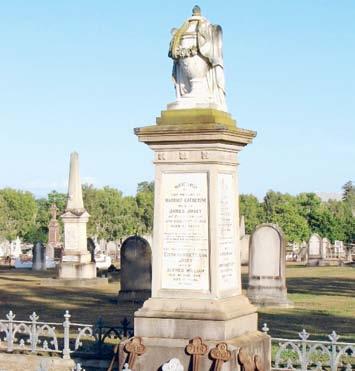
4 minute read
HISTORY ......................... pages
V ictim of the other vir us
Stories Behind the Tombstones is a series by JOHN ROSSITER, member of the Ipswich Genealogical Society. The series tells the stories of tombstones from the Ipswich Cemeter y and the pioneers of the city and district that lay in them.
Dr John Flynn ( 27.03.1870 - 06.06.1919) 1919 Influenza Epidemic - The death of Dr John Flynn came as a great blow to the people of Ipswich. Dr Flynn was a native of Ipswich having been born on 27th March, 1870 at Woodend – the first of nine children born to parents Thomas Flynn and Margaret (nee Mulqueeny). He was devoted to his work and rendered great service to many of his patients who had been victims of the epidemic which had travelled through Ipswich at that time. He too then became a victim of the dreaded disease which turned to pneumonia and claimed his life on 6th June, 1919 at the age of 49 years. At the time of his death he held the positions of Government Medical Officer for Ipswich and City Health Officer.
His early education was at the Bundamba State School under Mr J. Sydes, gaining a scholarship to attend the Ipswich Boys’ Grammar School. This was the start of his most successful career. At the end of this five year term he was dux of the school. Other notable people who were also in his form were Dr J. A. Cameron, the Hon. J. W. Blair, and Cr. W. R. Butler. At the age of 18 the ‘young Flynn’ commenced a term at the Melbourne University where he studied medicine. After this period he returned to Ipswich where he spent six months at the Ipswich Hospital under Dr P. Thornton, where he studied anatomy and dispensing.
He then spent time abroad where he attended Edinburgh University, gaining the degrees of L.R.C.P. and L.R.C.S.. Dr Thornton’s certificate, as to his ability, was recognised by the English authorities which saved him time in redoing such studies. Returning to the town of his birth about 1894 he soon set up in practice. He recognised the need for a private hospital in the Ipswich area and on Saturday 28th April, 1906 Ipswich helped him celebrate the opening of his ‘St Mary’s Private Hospital’ on the corner of Roderick and Murphy streets. The building, measuring 77ft x 66ft, contained 20 rooms where personal attention could be provided by his thoroughly skilled nurses for 12 patients at a time. The facility was not only for his patients but also accepted patients of any other medical practitioner.
Special attention was paid to improved sanitary arrangements. The old style earth-closets, with all their germs, were abandoned and in their place water-closets of enamelled porcelain were installed. All deposits were immediately washed away by a two gallon flush of water held in a cistern above. All surfaces were smooth with no corners where germs could linger and cause infections. All sinks and baths were also of smooth enamel surfaces.
As a special tribute to this native of the town, who had achieved so much in his short lifetime and which had benefited the community, the Union Jack was flown at half-mast from the Town Hall and Technical College on the day of his funeral. He left a widow, four sons and one daughter. His two eldest sons, Thomas and William, were at the time of his death, following in their father’s footsteps by studying medicine. Dr John Flynn ( 27.03.1870 - 06.06.1919).
Cour ting both sides of the law, ‘bad boy’ builds a life
By Ipswich Genealogical Society
James Josey (01.08.1821 - 21.02.1903) James Josey was born at Reading, Berkshire, England on 1 August 1821. On 22 February 1840, at the Berkshire Assizes, he was charged and found guilty of ‘robbing a waggon’.
Described as having a cocked nose and two moles under his left jaw, he was sentenced to 15 years imprisonment. He was at first placed on a hulk in the river, when the gaoler’s report described him as “bad in every respect”.
He was then transported to Australia on the sailing ship “Eden”, which arrived at Port Jackson on 18 November 1840. Five months later he was moved to Moreton Bay.
By around 1843 he was at Limestone (later known as Ipswich) when he and William Vowles were reported to have erected for George Nail, the first wooden building in the Ipswich area.
Following his early pioneering efforts in timber-getting at Pine Mountain and in the building trade, he was engaged in pastoral interests taking up considerable areas of land, mainly in the Redbank Plains district.
He was well known as a successful dairy farmer and horse breeder, as well as establishing the timber-getting industry in that district. At the time of his death he was the owner of 350 acres of the best farming land at Redbank Plains and 7000 acres at Possum Creek.
He married twice. His first marriage was to Harriet Catherine Harris on 22 December 1849, with whom they had 17 children. Harriet died on 15 January 1889. He then married Margaret Jones on 16 January 1890, who predeceased him by four months. When he died he had eight daughters and five sons who were scattered throughout the state.
He died on 21 February 1903 at his residence at Possum Creek, Redbank Plains at the ripe age of 83. His funeral took place at the Ipswich Cemetery, when apart from relatives, there were many prominent business men and others who honoured one of the oldest settlers in the district. The Church of England rector from St Paul’s (Rev. Dr. W. Pritchard) read the burial service.
James Josey was widely respected as having made a valuable contribution to the city and the surrounding areas of Ipswich. James Josey’s tombstone at Ipswich Cemeter y.









